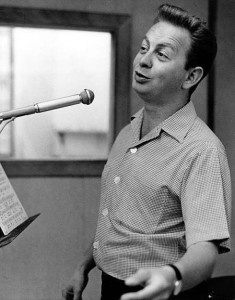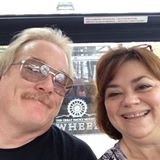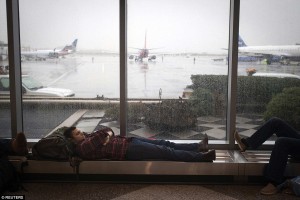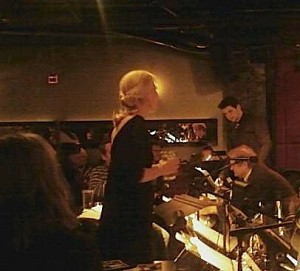 “It would be tough, all right. But at the same time it would be like finding a long straight path in front of you when you felt like running.”
“It would be tough, all right. But at the same time it would be like finding a long straight path in front of you when you felt like running.”
Richard Powell, The Philadelphian
Terry Teachout on the arts in New York City
 I have an essay about Mel Tormé in the new issue of Commentary. Here’s an excerpt:
I have an essay about Mel Tormé in the new issue of Commentary. Here’s an excerpt:
Greatly admired by his fans, he was never loved in the way Sinatra was loved in his lifetime, or the way Tony Bennett is loved today….
Some have speculated that Tormé’s wide-ranging talents prevented him from focusing with single-minded determination on his career as a vocalist. Among other things, he was one of the few top-tier pop singers who wrote high-quality songs, the best remembered of which is “The Christmas Song” (better known to casual listeners as “Chestnuts Roasting on an Open Fire”). He also wrote several very good books, not only about himself but about other artists he had known. Moreover, Tormé did enough acting—most of it on series TV, on occasion in his own teleplays—to suggest that he could have had a successful career as a character actor. And in addition to all this, he was a talented arranger, a competent jazz drummer, and a more than serviceable pianist.
But for all his varied accomplishments, Tormé was a singer first and foremost, and his fellow singers knew his worth. Toward the end of his life, Bing Crosby was asked in an interview to name his favorite musicians, and the only vocalist he mentioned was Tormé: “Any singer that goes to hear this guy sing has got to go and cut his throat.” What was it, then, that kept Tormé out of the pop-culture pantheon? Was his stylish singing caviar to the general? Or was something else at fault?…
Read the whole thing here.
* * *
Mel Tormé performs “I’ll Remember April” in “The Frozen Image,” a 1967 episode of Run for Your Life for which he also wrote the teleplay. He appears opposite Ben Gazarra, the star of the series:
I’ve seen most of Alfred Hitchcock’s major films, but for some reason Rope had eluded me until last week, when it popped up on Turner Classic Movies as part of a Jimmy Stewart marathon. Like most cinephiles, I didn’t find it very impressive, though I was fascinated to see John Dall camping it up as one of the two gotta-be-gay murderers, having only recently watched his straight-down-the-center performance as the hapless bank robber-victim of Gun Crazy.
That said, one thing about Rope struck me quite forcibly. In fact, it astonished me. About ten minutes or so into the first reel, Hitchcock’s wandering camera came to rest in front of a painting hanging in the dining room of the elaborate breakaway set on which Rope was filmed. As Dall and Farley Granger chatted away, I said to myself, “By God, that’s a Milton Avery.” To be exact, it appears to be a portrait of March Avery, the artist’s daughter, painted some time in the mid-to-late Forties….
Read the whole thing here.
I have two families, one in southeast Missouri and one in northeast Connecticut. By the time Mrs. T entered my life at the end of 2005, my mother’s health was in decline, so we “decided” willy-nilly to spend our Christmases with her in Smalltown, U.S.A., and our Thanksgivings with Mrs. T’s family in Connecticut. This worked pretty well, but after my mother died, we opted to stick to the East Coast throughout the holiday season, thus making it possible for us to finally have our own Christmas tree.
 A month and a half ago, Mrs. T suggested to me that I might want to consider spending Thanksgiving in Smalltown with David and Kathy, my brother and sister-in-law. It wasn’t a random notion on her part. Once Dave finished remodeling the house in which he and I grew up and into which he and Kathy have since moved, the two of them decided to invite Kathy’s entire family (which is both large and lively) over for Thanksgiving dinner. Hence it made good sense for me to fly out to Missouri, join in the general revelry, and spend a couple of days in the guest bedroom at 713 Hickory Drive while Mrs. T celebrated Thanksgiving with her own family in rural Connecticut.
A month and a half ago, Mrs. T suggested to me that I might want to consider spending Thanksgiving in Smalltown with David and Kathy, my brother and sister-in-law. It wasn’t a random notion on her part. Once Dave finished remodeling the house in which he and I grew up and into which he and Kathy have since moved, the two of them decided to invite Kathy’s entire family (which is both large and lively) over for Thanksgiving dinner. Hence it made good sense for me to fly out to Missouri, join in the general revelry, and spend a couple of days in the guest bedroom at 713 Hickory Drive while Mrs. T celebrated Thanksgiving with her own family in rural Connecticut.
Such well-made plans have a sneaky way of coming unglued at the last minute, and this one fell victim to the nasty winter weather that fouled up holiday travel on the East Coast last Wednesday. No sooner did I check the forecast on Tuesday morning than I figured out that if I took the train from Connecticut to New York that afternoon and attempted to fly from there to Missouri the next day, I stood a much-better-than-even chance of getting stranded at the airport. So I called up my always-sensible brother and talked the situation over with him at length, spent the next couple of hours silently rebelling against the inevitable, and decided in the end to stay put.
 It took me most of the afternoon to come to terms with my reluctant decision. It’s been years since I last spent Thanksgiving in Smalltown, and I was looking forward to my visit more than I can possibly say. Sometimes—quite often, truth to tell—it’s no fun to be sensible. But when I finally turned the corner and committed myself to having a good time in Connecticut…well, I had one. A very good time, in fact, and not just because I was spending the holiday with my beloved Mrs. T. The members of her family long ago accepted me as one of their own, and as I sat down on Thursday to a table laden with enough piping-hot food to stuff a football team, I felt completely, blessedly at home.
It took me most of the afternoon to come to terms with my reluctant decision. It’s been years since I last spent Thanksgiving in Smalltown, and I was looking forward to my visit more than I can possibly say. Sometimes—quite often, truth to tell—it’s no fun to be sensible. But when I finally turned the corner and committed myself to having a good time in Connecticut…well, I had one. A very good time, in fact, and not just because I was spending the holiday with my beloved Mrs. T. The members of her family long ago accepted me as one of their own, and as I sat down on Thursday to a table laden with enough piping-hot food to stuff a football team, I felt completely, blessedly at home.
And did I miss Dave, Kathy, my dear niece Lauren and all the other Teachouts and Merideths who were doing the same thing at the same time halfway across the country? You’d better believe it. I missed them fiercely, and still do. But to have two families, both of which love you, is the nicest of problems, one that needs no solution. All it calls for is gratitude, with which I was—and am, and ever will be—overflowing.
On Sunday afternoon Mrs. T and I departed Connecticut and slogged our endless way through post-holiday traffic, finally reaching our Manhattan apartment just in time to turn around and head downtown to the Jazz Standard to catch Maria Schneider’s first set and eat shrimp and grits and deviled eggs (the Jazz Standard being one of a handful of jazz clubs whose cuisine is noteworthy).
 Maria and I go back a long way. I wrote about her for the first time twenty years ago in The Wall Street Journal, and she has figured prominently on this blog ever since I launched it in 2003. I know her music well and admire it without reserve. She is one of the very few artists of my acquaintance whom I would unhesitatingly call a genius (though she never acts like one). Yet she’s still capable of astonishing me after all these years, which was what happened last night when her band played “The Thompson Fields,” the title track of her newly recorded album, about which you can read by going here.
Maria and I go back a long way. I wrote about her for the first time twenty years ago in The Wall Street Journal, and she has figured prominently on this blog ever since I launched it in 2003. I know her music well and admire it without reserve. She is one of the very few artists of my acquaintance whom I would unhesitatingly call a genius (though she never acts like one). Yet she’s still capable of astonishing me after all these years, which was what happened last night when her band played “The Thompson Fields,” the title track of her newly recorded album, about which you can read by going here.
Maria and her big band always spend the week of Thanksgiving in residence at the Jazz Standard, and Mrs. T and I usually go to hear them there. We weren’t able to make it into town last year, though, meaning that I hadn’t heard any of her music performed live since Duke: A Life of Duke Ellington was published. Perhaps for that reason, Ellington was much on my mind as I listened to “The Thompson Fields.” It’s what he would have called a “tone parallel” of the Minnesota farm country where Maria grew up, a musical landscape that is by turns delicate and grand. She is our Ellington, I thought. She paints with sound. But almost in the same instant I found myself thinking of another great composer, Aaron Copland. Like Appalachian Spring or Twelve Poems of Emily Dickinson, Maria’s spacious, sweepingly lyrical music speaks to the listener in an accent that is uniquely and unmistakably American—and like those two masterpieces, it drew unexpected tears from me.
“My God, Maria, that was beautiful,” I told her after the set was over. “Beautiful like Copland.”
“Did you really think so?” she asked, her face aglow with unselfconscious delight. “I thought it went pretty well at the recording session.”
“I bet it did,” I replied. “I just bet it did.”
* * *
A promotional video for The Thompson Fields:
 A brief 1929 film clip of George Gershwin playing the title song of Strike Up the Band at a rehearsal for the show’s Broadway premiere. Gershwin can also be heard speaking at the beginning of the clip:
A brief 1929 film clip of George Gershwin playing the title song of Strike Up the Band at a rehearsal for the show’s Broadway premiere. Gershwin can also be heard speaking at the beginning of the clip:
(This is the latest in a series of arts-related videos that appear in this space each Monday and Wednesday.)
 “You’d never find him leading a mob against a barricade. He’d be peering out from a doorway, thinking what idiots they were on both sides of the barricade. The man might be dangerous if he really believed in anything, but he doesn’t. It’s like a devil who doesn’t want the bother of running a hell.”
“You’d never find him leading a mob against a barricade. He’d be peering out from a doorway, thinking what idiots they were on both sides of the barricade. The man might be dangerous if he really believed in anything, but he doesn’t. It’s like a devil who doesn’t want the bother of running a hell.”
Richard Powell, The Philadelphian
An ArtsJournal Blog